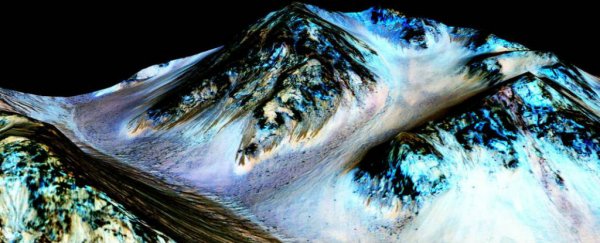This article was written by Andrew Coates from UCL and was originally published by The Conversation.
Water played a key role in the early history of Mars, some 3.8 billion years ago, before it became cold and dry. In the past few years, scientists have found evidence of much more recent liquid water: gullies apparently formed by running water within the last million years, and regions where salty liquid water may seep to the surface even now. But a new study, published in Nature Geoscience, shows that these Martian gullies, which resemble water-sculpted gullies on our own planet, may have been formed by dry ice instead.
A number of past missions have found evidence of water and water ice on Mars - building the evidence for a warm, wet past on a potentially habitable Mars some 3.8 billion years ago.
The Viking orbiter found large networks of outflow channels, which are thought to be due to ancient surface water. Mars Global Surveyor discovered several gullies on slopes near crater rims, consisting of alcoves, channels and deposited material, which were attributed to the more recent effects of running water, which was apparently coming to the surface from below and transporting material down slopes.
Mars Odyssey also found local, large-scale concentrations of hydrogen below the surface, implying there is water in polar and equatorial regions.
 Branched gullies Jim Secosky/NASA
Branched gullies Jim Secosky/NASAThe Phoenix Mars Lander found direct evidence of water ice - effectively permafrost, near the North pole - which escaped into the thin atmosphere as vapour when the lander dug a shallow trench with a scoop. It also detected droplets of water on its own leg.
Most recently, Mars Reconnaisance Orbiter looked in more detail at the gullies and also dark streaks on the planet's slopes, known as "recurrent slope lineae", finding that they are seasonal and implying that flowing liquid water exists now.
Alternative processes
However, another explanation for the gullies has now been proposed. The new study shows that large amounts of water would have been needed very recently to explain the distribution of the gullies and their dimensions - a challenge to our overall picture of Mars's history.
The explanation involves carbon dioxide - the principal component of Mars's thin atmosphere, and also the composition of much of the seasonal icecaps and frost. If the CO2 frost becomes thick enough it would eventually, as it warms in the spring, anneal to become a translucent ice layer.
Sunlight could penetrate to the under side and cause some of it to vaporise without turning into a liquid, a process known as sublimation. Eventually this could blow out, bringing surface material with it, eventually creating gully features.
 Gullies on Earth (Aoineadh Beinn na Sroine, UK). Andy Waddington, CC BY-SA
Gullies on Earth (Aoineadh Beinn na Sroine, UK). Andy Waddington, CC BY-SAThe authors made a detailed computer model based on Mars's surface and atmospheric details, including frost locations, seasonal formation and thickening. They mapped the latitudes and slopes where the sublimation and blow out can occur, and found a good match with the observed locations of gullies.
They also looked at the effect of the changing tilt of Mars's spin axis over the last million years, which affects the climate and amount of sunlight it gets, and showed that, again, gully formation driven by sublimation and blow out agrees with the changes. However the model cannot reproduce all aspects and it may be that other processes involving water or ice may be important, too.
Nevertheless, their results show that dry ice, rather than flowing water, could well be the dominant formation process. However, that doesn't mean there is no flowing water on Mars - just that it may not have formed the gullies. The dark streaks on the planet's slopes indicate that water may still be seeping to the surface today.
Recent missions have concentrated on water and its history and effects on Mars. But the study shows that we must not be too guided by the processes occurring on our own planet. We should be open to other mechanisms on other worlds.
Future missions and analysis may help to prove once and for all whether the gullies were caused by running water or not. But this is not all - they will also be trying to understand other puzzles.
For example, the interior structure of Mars will be probed by NASA's Insight mission in 2016. Trace amounts of mysterious methane, which should be dissociated by sunlight and thus short lived in the Martian atmosphere, will also be investigated. There must be a recent source - either geothermal activity or some sort of microbial life. ExoMars 2016 will follow this up by mapping the methane on the planet.
Even more excitingly, the European Space Agency and Russia will look for actual signs of life by drilling underneath the harsh surface with the ExoMars 2018 rover, and then NASA will further explore habitability with Mars 2020. The next few years will be interesting ones for Mars exploration - hopefully unveiling many of the red planet's innermost secrets.
![]() Andrew Coates, Professor of Physics, Deputy Director (Solar System) at the UCL Mullard Space Science Laboratory, UCL.
Andrew Coates, Professor of Physics, Deputy Director (Solar System) at the UCL Mullard Space Science Laboratory, UCL.
This article was originally published by The Conversation. Read the original article.
